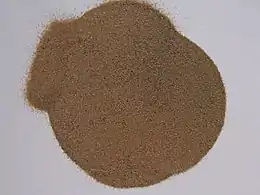Actinides in the environment
Actinides in the environment refer to the sources, environmental behaviour and effects of actinides in Earth's environment. Environmental radioactivity is not limited solely to actinides; non-actinides such as radon and radium are of note. While all actinides are radioactive, there are a lot of actinides or actinide-relating minerals in the Earth's crust such as uranium and thorium. These minerals are helpful in many ways, such as carbon-dating, most detectors, X-rays, and more.
Inhalation versus ingestion
Generally, ingested insoluble actinide compounds, such as high-fired uranium dioxide and mixed oxide (MOX) fuel, will pass through the digestive system with little effect since they cannot dissolve and be absorbed by the body. Inhaled actinide compounds, however, will be more damaging as they remain in the lungs and irradiate the lung tissue.
Ingested low-fired oxides and soluble salts such as nitrate can be absorbed into the blood stream. If they are inhaled then it is possible for the solid to dissolve and leave the lungs. Hence, the dose to the lungs will be lower for the soluble form.
Actinium in the environment
Actinium can be naturally found in traces in uranium ores as 227-Ac, an α and β emitter with a half-life of 21.773 years. One ton of uranium ore contains about a tenth of a gram of actinium. It's more commonly made in milligram amounts by the neutron irradiation of 226-Ra in a nuclear reactor. Naturally occurring actinium is composed of 1 radioactive isotope; with 227-Ac being the most abundant (100% natural abundance).
Thorium in the environment

In India, a large amount of thorium ore can be found in the form of monazite in placer deposits of the Western and Eastern coastal dune sands, particularly in the Tamil Nadu coastal areas. The residents of this area are exposed to a naturally occurring radiation dose ten times higher than the worldwide average.[1]
Occurrence
Thorium is found at low levels in most rocks and soils, where it is about three times more abundant than uranium, and is about as common as lead. Soil commonly contains an average of around 6 parts per million (ppm) of thorium.[2] Thorium occurs in several minerals, the most common being the rare earth-thorium-phosphate mineral, monazite, which contains up to about 12% thorium oxide. There are substantial deposits in several countries. 232Th decays very slowly (its half-life is about three times the age of the earth). Other isotopes of thorium occur in the thorium and uranium decay chains. Most of these are short-lived and hence much more radioactive than 232Th, though on a mass basis they are negligible.
Effects in humans
Thorium has been linked to liver cancer. In the past thoria (thorium dioxide) was used as a contrast agent for medical X-ray radiography but its use has been discontinued. It was sold under the name Thorotrast.
Protactinium in the environment
Protactinium-231 occurs naturally in uranium ores such as pitchblende, to the extent of 3 ppm in some ores. Protactinium is naturally present in soil, rock, surface water, groundwater, plants and animals in very low concentrations (on the order of 1 ppt or 0.1 picocouries (pCi)/g).
Uranium in the environment
Uranium is a natural metal which is widely found. It is present in almost all soils and it is more plentiful than antimony, beryllium, cadmium, gold, mercury, silver, or tungsten, and is about as abundant as arsenic or molybdenum. Significant concentrations of uranium occur in some substances such as phosphate rock deposits, and minerals such as lignite, and monazite sands in uranium-rich ores (it is recovered commercially from these sources).
Seawater contains about 3.3 parts per billion of uranium by weight[3] as uranium (VI) forms soluble carbonate complexes. The extraction of uranium from seawater has been considered as a means of obtaining the element. Because of the very low specific activity of uranium the chemical effects of it upon living things can often outweigh the effects of its radioactivity. Additional uranium has been added to the environment in some locations as a result of the nuclear fuel cycle and the use of depleted uranium in munitions.
Neptunium in the environment
Like plutonium, neptunium has a high affinity for soil.[4] However, it is relatively mobile over the long term, and diffusion of neptunium-237 in groundwater is a major issue in designing a deep geological repository for permanent storage of spent nuclear fuel. 237Np has a half-life of 2.144 million years and is therefore a long-term problem; but its half-life is still much shorter than those of uranium-238, uranium-235, or uranium-236, and 237Np therefore has higher specific activity than those nuclides. It is used only to make Pu-237 when bombarded with neutrons in a lab.
Plutonium in the environment
Sources
Plutonium in the environment has several sources. These include:
- Atomic batteries
- In space
- In pacemakers
- Bomb detonations
- Bomb safety trials
- Nuclear crime
- Nuclear fuel cycle
- Nuclear power plants
Environmental chemistry
Plutonium, like other actinides, readily forms a plutonium dioxide (plutonyl) core (PuO2). In the environment, this plutonyl core readily complexes with carbonate as well as other oxygen moieties (OH−, NO2−, NO3−, and SO42−) to form charged complexes which can be readily mobile with low affinities to soil.
- PuO2CO32−
- PuO2(CO3)24−
- PuO2(CO3)36−
PuO2 formed from neutralizing highly acidic nitric acid solutions tends to form polymeric PuO2 which is resistant to complexation. Plutonium also readily shifts valences between the +3, +4, +5 and +6 states. It is common for some fraction of plutonium in solution to exist in all of these states in equilibrium.
Plutonium is known to bind to soil particles very strongly, see above for an X-ray spectroscopic study of plutonium in soil and concrete. While caesium has very different chemistry to the actinides, it is well known that both caesium and many of the actinides bind strongly to the minerals in soil. Hence it has been possible to use 134Cs labeled soil to study the migration of Pu and Cs is soils. It has been shown that colloidal transport processes control the migration of Cs (and will control the migration of Pu) in the soil at the Waste Isolation Pilot Plant.[5]
Americium in the environment
Americium often enters landfills from discarded smoke detectors. The rules associated with the disposal of smoke detectors are very relaxed in most municipalities. For instance, in the UK it is permissible to dispose of an americium containing smoke detector by placing it in the dustbin with normal household rubbish, but each dustbin worth of rubbish is limited to only containing one smoke detector. The manufacture of products containing americium (such as smoke detectors) as well as nuclear reactors and explosions may also release the americium into the environment.[6]

In 1999, a truck transporting 900 smoke detectors in France had been reported to have caught fire; it is claimed that this led to a release of americium into the environment.[7] In the U.S., the "Radioactive Boy Scout" David Hahn was able to buy thousands of smoke detectors at remainder prices and concentrate the americium from them.
There have been cases of humans being exposed to americium. The worst case was that of Harold McCluskey, who was exposed to an extremely high dose of americium-241 after an accident involving a glove box. He was subsequently treated with chelation therapy. It is likely that the medical care which he was given saved his life: despite similar biodistribution and toxicity to plutonium, the two radioactive elements have different solution-state chemistries.[8] Americium is stable in the +3 oxidation state, while the +4 oxidation state of plutonium can form in the human body.[9]
The most common isotope americium-241 decays (half-life of 432 years) to neptunium-237 which has a much longer half-life, so in the long term, the issues discussed above for neptunium apply.[10]
Americium released into the environment tends to remain in soil and water at relatively shallow depths and may be taken up by animals and plants during growth; shellfish such as shrimp take up americium-241 in their shells, and parts of grain plants can become contaminated with exposure.[11]
Curium in the environment
Curium can be found in minute amounts in some uranium mineral deposits.[12] It's really only used in spacecraft to power the electrical equipment in rovers. Curium can be dangerous when exposed to because of the radiation its emitting, which is even greater than Americium.
References
- "Compendium Of Policy And Statutory Provisions Relating To Exploitation Of Beach Sand Minerals". Government Of India. Archived from the original on 2008-12-04. Retrieved 2008-12-19.
- THORIUM Agency for Toxic Substances and Disease Registry. July 1999.
- "Uranium: the essentials". WebElements. Retrieved 2008-12-19.
- "Neptunium" (PDF). Argonne National Laboratory, EVS. August 2005. Archived from the original (PDF) on 2008-12-19. Retrieved 2008-12-19.
- Whicker, R.D.; S.A. Ibrahim (2006). "Vertical migration of 134Cs bearing soil particles in arid soils: implications for plutonium redistribution". Journal of Environmental Radioactivity. 88 (2): 171–188. doi:10.1016/j.jenvrad.2006.01.010. PMID 16564117.
- Bunzl, K.; Kracke, W. (1994). "Fate of fall-out plutonium and americium in the environment: selected examples". Journal of Alloys and Compounds. Elsevier B.V. 213–214: 212–218. doi:10.1016/0925-8388(94)90906-7.
- "Radiological Agent: Americium-241". CBWInfo.com. Archived from the original on 2009-01-08. Retrieved 2008-12-19.
- Taylor, David M. (July 1989). "The biodistribution and toxicity of plutonium, americium and neptunium". Science of the Total Environment. 83 (3): 217–225. doi:10.1016/0048-9697(89)90094-6.
- PubChem. "Americium". pubchem.ncbi.nlm.nih.gov. Retrieved 2019-12-13.
- Stoll 2017-10-10T22:55:00Z, Carol. "Facts About Neptunium". livescience.com. Retrieved 2019-12-13.
- "Public Health Statement for Americium". CDC - ATSDR. Retrieved 11 September 2016.
- "Curium".
- Burakov, B. E.; Ojovan, M. I.; Lee, W. E. (2010). Crystalline Materials for Actinide Immobilisation. London: Imperial College Press. ISBN 978-1-84816-418-5. Archived from the original on 2012-03-09.
Further reading
- Hala, Jiri, and James D. Navratil. Radioactivity, Ionizing Radiation and Nuclear Energy. Konvoj: Brno, Czech Republic, 2003. ISBN 80-7302-053-X.
External links
- Royal Society for Chemistry - Why do mechanisms matter in radioactive waste management?
- Federation of American Scientists - Spectroscopies for Environmental Studies of Actinide Species
